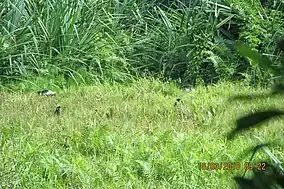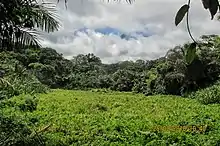Ngoyla Faunal Reserve
The Ngoyla Faunal Reserve is a 1,566 sq km-large protected area, which is situated in the south-eastern part of Cameroon.[1] It is an important shelter and corridor for the Congolian rainforests megafauna within the tri-national Dja-Odzala-Minkébé protected area complex (TRIDOM).[2]
| Ngoyla Faunal Reserve | |
|---|---|
IUCN category IV (habitat/species management area)[1] | |
 | |
 Ngoyla Faunal Reserve (Cameroon) | |
| Location | Haut-Nyong, East Region, Cameroon |
| Nearest town | Lomié |
| Coordinates | 2°24′N 13°51′E |
| Area | 1,566 km2 (605 sq mi)[1] |
| Elevation | 500-600 m |
| Designated | 27 August 2014 |
Description
The Ngoyla Faunal Reserve was officially created by the MINFOF (Ministry of Forestry and Wildlife) in 2014 with the support of WWF.[3][2] It is found in the south-central part of the Ngoyla-Mintom massif. The climate of the reserve is tropical with two wet and two dry seasons. The annual precipitation is 1,500 mm in the northern, and 2,000 mm in the southern area, the average annual temperature is 24-25 °C due to the elevation (500-600 meters a.s.l.). Characteristic vegetation types are humid evergreen rainforests (82%), swamp forests (15%), natural forest clearances (2%), and secondary forest-farmbush mosaics (1%). Its biodiversity is notable; 230 fish, 280 bird, and 37 large and medium-sized mammal species have been recorded. Notable mammal species are the African forest elephant (Loxodonta cyclotis), western lowland gorilla (Gorilla gorilla gorilla), central chimpanzee (Pan troglodytes troglodytes), mandrill (Mandrillus sphinx), leopard (Panthera pardus), African forest buffalo (Syncerus caffer nanus), western bongo (Tragelaphus eurycerus), sitatunga (Tragelaphus spekii), and forest duikers.[2] Besides the high density and diversity of forest animals, the Ngolya Faunal Reserve is an important corridor to migrating species, such as forest elephants by connecting the Dja Faunal Reserve, the Nki National Park, and the Minkébé National Park of Gabon, due to its location within the TRIDOM complex.[1]
Tourism
The Ngoyla Faunal Reserve is relatively close to the capital Yaoundé (450 km), compared to most of the popular Congo Basin protected areas of Cameroon. It is a stronghold of large mammals; in addition, it is rich in forest clearances that attract forest elephants, gorillas, and forest buffalos, making an excellent destination for wildlife lovers. The largest natural forest clearance, the 14 hectares-large Namodomo is a subject of an ecotourism development project, which aims to establish a wildlife observation tower and accommodation for international ecotourism.
See also


References
- "Ngoyla". Protected Planet. UNEP-WCMC. Retrieved 2020-07-12.
- "Ngoyla-Mintom Forest Block". www.wwf-congobasin.org. WWF. Retrieved 2020-07-12.
- "Décret n° 2014/2383/PM du 27 aout 2014 portant création de la Réserve de Faune de Ngoyla". spm.gov.cm (in French). Republic of Cameroon, Prime Minister's Office. Retrieved 4 August 2020.